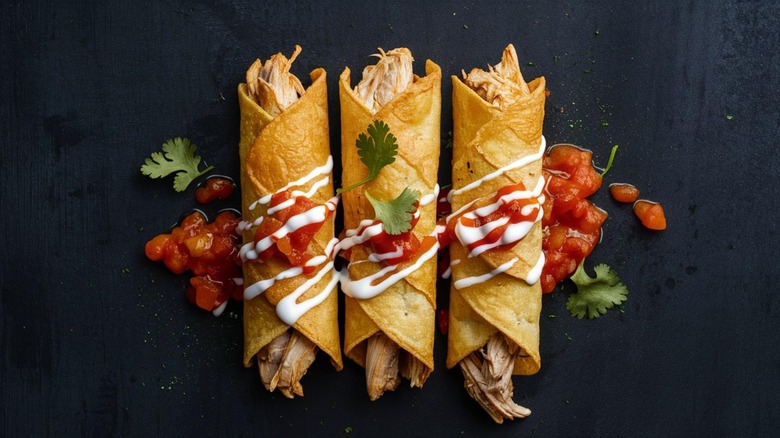Flautas Vs Enchiladas: How Do These Mexican Dishes Differ?
There's an old bit by comic Jim Gaffigan where he acts out the way a server might describe various Mexican dishes to a clueless diner. Each menu item gets described as a "tortilla with meat, cheese, and vegetables." It's true that these ingredients are the backbone of many Mexican foods, but individual dishes all have their own distinctive traits. Take flautas and enchiladas, for example.
Both dishes are essentially tortillas rolled around savory meat fillings and are believed to have existed since ancient times. While the origin story of flautas is a bit murky, they may have first been made by Indigenous peoples centuries ago. Enchiladas, meanwhile, can be traced back to the Aztec empire.
Still, despite their similarities, the preparation, presentation, and even the type of tortilla used set flautas and enchiladas apart. A key difference lies in their textures. Flautas are meant to be crispy, while enchiladas are prepared so that the tortillas remain soft. If you're in the mood for something crisp and handheld or for a rich comfort food, understanding the differences will help you pick one to satisfy your hunger.
Flautas are all about the crisp
Flautas get their name from the Spanish word for "flute," as their shape resembles that of the instrument. These tasty treats are made by rolling a flour tortilla (some variations may use corn, but flour is most common for this dish) around fillings like shredded chicken, beef, or roasted pork. Then, they are fried until the tortilla becomes golden and crispy. What you get is a handheld, savory snack or meal with a delightful crisp.
Flautas are also often topped with condiments like sour cream, guacamole, or salsa to finish them off. You might see them served on a bed of fresh lettuce or with shredded lettuce on top. You don't normally find cheese inside of the rolled tortilla, but it can be topped with an option like Cacique Ranchero Queso Fresco or Queso Campesino Cojita for a tasty finish.
Each bite gives you a satisfying crunch, which offers a nice contrast with the soft, savory filling. They can be served with a side of fresh veggies or a simple salad, making them a lighter choice. While they're typically deep-fried, some variations involve air-frying flautas for a healthier twist. But achieving the signature crunch is always the goal.
Enchiladas are a saucy comfort food classic
"Enchilada" is one of the essential words to know at a Mexican restaurant. This dish is all about bold flavors and saucy comfort. An early form of enchiladas was called "chīllapīzzali" in Nahuatl, meaning "chili flute." True to the name, chili peppers are key to the flavor profile. To make enchiladas, corn tortillas are filled with ingredients like shredded chicken or ground beef, cheese, or beans and then rolled and smothered with chili sauce before being baked.
The tortillas soak up the sauce while baking for a tender, saucy texture. Many variations top the dish with melted cheese and chopped onions, and they can be finished with herbs and condiments like fresh cilantro and sour cream.
One great aspect of enchiladas is their versatility. Whether you're after something mild and cheesy or something that packs more heat, the fillings and sauces can be adjusted to match your preferences. The dish is often served with a side of rice and beans, making it a heartier meal that's perfect for dinner or a big lunch. However, you don't need to make your enchilada hearty; veggie versions can feature ingredients like mushrooms for a lighter meal.


